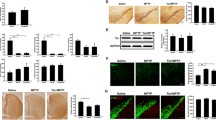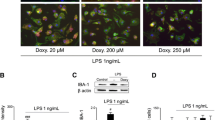Abstract
Microglia have undergone extensive characterization and have been shown to present distinct phenotypes, such as the M1 or M2 phenotypes, depending on their stimuli. As a highly specific neurotoxin, 6-hydroxydopamine (6-OHDA) can be used to further our understanding of the immune response in Parkinson’s disease (PD). Dexmedetomidine (DEX), a centrally selective α2-adrenoceptor agonist, performs very well as an anti-anxiety medication, sedative and analgesic. In the present study, we investigated the effects of DEX on 6-OHDA-induced microglial polarization. Our results indicate that treatment with 6-OHDA promotes microglial polarization toward the M1 state in BV2 microglia cells by increasing the release of interleukin (IL)-6, IL-1β, or tumor necrosis factor-α, which can be prevented by pretreatment with DEX. In addition, we found that 6-OHDA blocked IL-4-mediated microglial M2 polarization by suppressing expression of the microglial M2 markers arginase-1 (Arg-1), resistin-like α (Retnla/Fizz1), and chitinase 3-like 3 (Chi3l3/Ym1), which could be ameliorated by pretreatment with DEX. Notably, the inhibitory effects of 6-OHDA on IL-4-mediated induction of the anti-inflammatory marker genes IL-10, IL-13, and transforming growth factor-β2 could be significantly alleviated by pretreatment with DEX in a dose-dependent manner (P < 0.01). Mechanistically, alternations in the activation of signal transducer and activator of transcription 6 were involved in this process. These findings suggest that administration of DEX has the potential to interrupt the process of microgliosis in PD.







Similar content being viewed by others
References
Barcia C, Sánchez Bahillo A, Fernández-Villalba E, Bautista V, Poza Y, Poza M, Fernández-Barreiro A, Hirsch EC, Herrero MT (2004) Evidence of active microglia in substantia nigra pars compacta of Parkinsonian monkeys 1 year after MPTP expo-sure. Glia 46:402–409
Jha MK, Lee WH, Suk K (2016) Functional polarization of neuroglia: implications in neuroinflammation and neurological disorders. Biochem Pharmacol 103:1–16
Orihuela R, McPherson CA, Harry GJ (2016) Microglial M1/M2 polarization and metabolic states. Br J Pharmacol 173(4):649–665
Cherry JD, Olschowka JA, O’Banion MK (2014) Neuroinflammation and M2 microglia: the good, the bad, and the inflamed. J Neuroinflamm 11:98
Yan JQ, Sun JC, Zhai MM, Cheng LN, Bai XL, Feng CL (2015) Lovastatin induces neuroprotection by inhibiting inflammatory cytokines in 6-hydroxydopamine treated microglia cells. Int J Clin Exp Med 8(6):9030–9037
Wang HM, Zhang T, Li Q, Huang JK, Chen RF, Sun XJ (2013) Inhibition of glycogen synthase kinase-3β by lithium chloride suppresses 6-hydroxydopamine-induced inflammatory response in primary cultured astrocytes. Neurochem Int 63(5):345–353
Crotty S, Fitzgerald P, Tuohy E, Harris DM, Fisher A, Mandel A, Bolton AE, Sullivan AM, Nolan Y (2008) Neuroprotective effects of novel phos-phatidylglycerol-based phospholipids in the 6-hydroxydopamine model of Parkinson’s dis-ease. Eur J Neurosci 27:294–300
Farbood Y, Sarkaki A, Dolatshahi M, Ta qhi Mansouri SM, Khodadadi A (2015) Ellagic acid protects the brain against 6-hydroxydopamine induced neuroinflammation in a rat model of Parkinson’s disease. Basic Clin Neurosci 6(2):83–89
Singh S, Kumar P (2016) Neuroprotective potential of curcumin in combination with piperine against 6-hydroxy dopamine induced motor deficit and neurochemical alterations in rats, Inflammopharmacology 7:1–11
Levesque S, Wilson B, Gregoria V, Thorpe LB, Dallas S, Polikov VS, Hong JS, Block ML (2010) Reactive microgliosis: extracellular micro-calpain and microglia-mediated dopaminergic neurotoxicity. Brain 133:808–821
Ebert TJ, Hall JE, Barney JA, Uhrich TD, Colinco MD (2000) The effects of increasing plasma concentrations of dexmedetomidine in humans. Anesthesiology 93(2):382–394
Wang X, Zhao B, Li X (2015) Dexmedetomidine attenuates isoflurane-induced cognitive impairment through antioxidant, anti-inflammatory and anti-apoptosis in aging rat. Int J Clin Exp Med 8(10):17281–17288
Zeng X, Wang H, Xing X, Wang Q, Li W (2016) Dexmedetomidine protects against transient global cerebral oxidative stress and inflammation in diabetic rats. PLoS ONE 11(3):e0151620
Zhu YJ, Peng K, Meng XW, Ji FH (2016) Attenuation of neuroinflammation by dexmedetomidine is associated with activation of a cholinergic anti-inflammatory pathway in a rat tibial fracture model. Brain Res 1644:1–8
Sheng B, Wang X, Su B, Lee HG, Casadesus G, Perry G, Zhu X (2012) Impaired mitochondrial biogenesis contributes to mitochondrial dysfunction in Alzheimer’s disease. J Neurochem 120:419–429
Xie C, Wang Z, Tang J, Shi Z, He Z (2015) The effect of dexmedetomidine post-treatment on the inflammatory response of astrocyte induced by lipopolysaccharide. Cell Biochem Biophys 71(1):407–412
Brodacki B, Staszewski J, Toczyłowska B, Kozłowska E, Drela N, Chalimoniuk M, Stepien A (2008) Serum interleukin (IL-2, IL-10, IL-6, IL-4), TNFalpha, and INFgamma concentrations are elevated in patients with atypical and idiopathic parkinsonism. Neurosci Lett 2:158–162
Chen T, Hou R, Xu S, Wu C (2015) Donepezil regulates 1-methyl-4-phenylpyridinium-induced microglial polarization in Parkinson’s disease. ACS Chem Neurosci 6(10):1708–1714
Joniec-Maciejak I, Ciesielska A, Wawer A, Sznejder-Pacholek A, Schwenkgrub J, Cudna A, Hadaczek P, Bankiewicz KS, Czlonkowska A, Czlonkowski A (2014) The influence of AAV2- mediated gene transfer of human IL-10 on neurodegeneration and immune response in a murine model of Parkinson’s disease. Pharmacol Rep 66:660–669
Peng M, Wang YL, Wang CY, Chen C (2013) Dexmedetomidine attenuates lipopolysaccharide-induced proinflammatory response in primary microglia. J Surg Res 179(1):e219–e225
Kose EA, Bakar B, Kasimcan O, Atilla P, Kilinc K, Muftuoglu S, Apan A (2013) Effects of intracisternal and intravenous dexmedetomidine on ischemia-induced brain injury in rat: a comparative study. Turk Neurosurg 23(2):208–217
Eser O, Fidan H, Sahin O, Cosar M, Yaman M, Mollaoglu H et al (2008) The influence of dexmedetomidine on ischemic rat hippocampus. Brain Res 1218:250–256
Hu X, Leak RK, Shi Y, Suenaga J, Gao Y, Zheng P, Chen J (2014) Microglial and macrophage polarization-new prospects for brain repair. Nat Rev Neurol 11(1):56–64
Chen W, Liu B, Zhang F, Xue P, Cui R, Lei W (2015) The effects of dexmedetomidine on post-operative cognitive dysfunction and inflammatory factors in senile patients. Int J Clin Exp Med 8(3):4601–4605
Wu Y, Liu Y, Huang H, Zhu Y, Zhang Y, Lu F, Zhou C, Huang L, Li X, Zhou C (2013) Dexmedetomidine inhibits inflammatory reaction in lung tissues of septic rats by suppressing TLR4/NF-κB pathway. Mediators Inflamm 2013:562154
Author information
Authors and Affiliations
Corresponding author
Rights and permissions
About this article
Cite this article
Zhang, P., Li, Y., Han, X. et al. Dexmedetomidine Regulates 6-hydroxydopamine-Induced Microglial Polarization. Neurochem Res 42, 1524–1532 (2017). https://doi.org/10.1007/s11064-017-2209-9
Received:
Revised:
Accepted:
Published:
Issue Date:
DOI: https://doi.org/10.1007/s11064-017-2209-9




